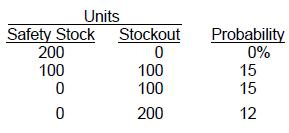Sharpen Your Knowledge with AICPA (CPA-Business) Certification Sample Questions
CertsTime has provided you with a sample question set to elevate your knowledge about the AICPA CPA Business Environment and Concepts exam. With these updated sample questions, you can become quite familiar with the difficulty level and format of the real CPA-Business certification test. Try our sample AICPA CPA Business Environment and Concepts certification practice exam to get a feel for the real exam environment. Our sample practice exam gives you a sense of reality and an idea of the questions on the actual AICPA Certified Public Accountant certification exam.
Our sample questions are similar to the Real AICPA CPA CPA-Business exam questions. The premium AICPA CPA Business Environment and Concepts certification practice exam gives you a golden opportunity to evaluate and strengthen your preparation with real-time scenario-based questions. Plus, by practicing real-time scenario-based questions, you will run into a variety of challenges that will push you to enhance your knowledge and skills.
AICPA CPA-Business Sample Questions:
The Frame Supply Company has just acquired a large account and needs to increase its working capital by $100,000. The controller of the company has identified four alternative sources of funds, which are given below.
A: Pay a factor to buy the company's receivables, which average $125,000 per month and have an average collection period of 30 days. The factor will advance up to 80 percent of the face value of receivables at 10 percent and charge a fee of 2 percent of all receivables purchased. The controller estimates that the firm would save $24,000 in collection expenses over the year. Assume the fee and interest are not deductible in advance.
B: Borrow $110,000 from a bank at 12 percent interest. A 9 percent compensating balance would be required.
C: Issue $110,000 of six-month commercial paper to net $100,000. (New paper would be issued every 6 months.)
D: Borrow $125,000 from a bank on a discount basis at 20 percent. No compensating balance would be required.
Assume a 360-day year in all of your calculations.
The cost of Alternative D . is:
When the Economic Order Quantity (EOQ) model is used for a firm, which manufactures its inventory, ordering costs consist primarily of:
An example of a carrying cost is:
Handyman Inc. operates a chain of hardware stores across New England. The controller wants to determine the optimum safety stock levels for an air purifier unit. The inventory manager has compiled the following data.
* The annual carrying cost of inventory approximates 20 percent of the investment in inventory.
* The inventory investment per unit averages $50.
* The stockout cost is estimated to be $5 per unit.
* The company orders inventory on the average of ten times per year.
* Total cost = carrying cost + expected stockout cost.
* The probabilities of a stockout per order cycle with varying levels of safety stock are as follows.

The total cost of safety stock on an annual basis with a safety stock level of 100 units is:
Which one of the following would not be considered a carrying cost associated with inventory?
Note: If there is any error in our AICPA CPA-Business certification exam sample questions, please update us via email at support@certstime.com.



 Try Before You Buy!
Try Before You Buy!